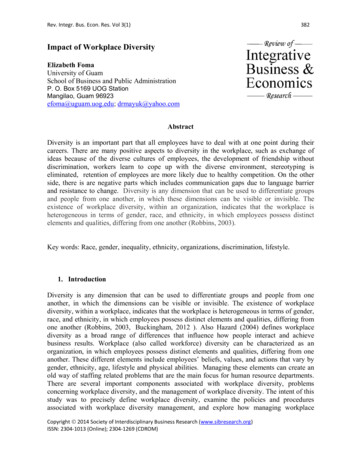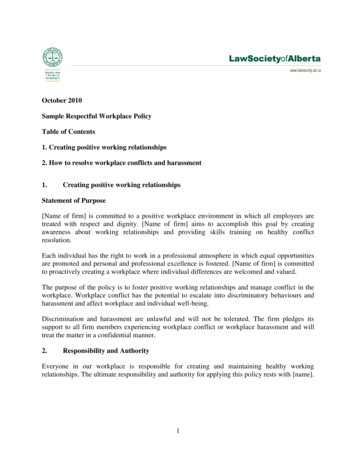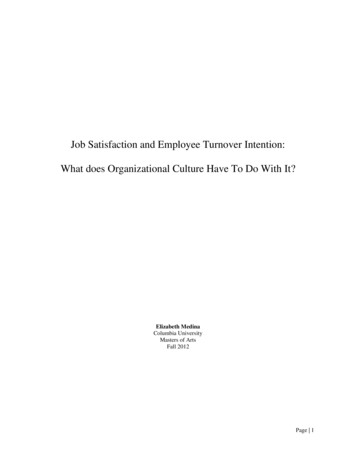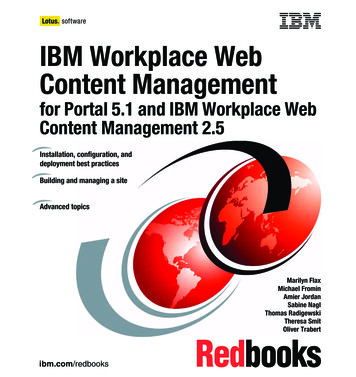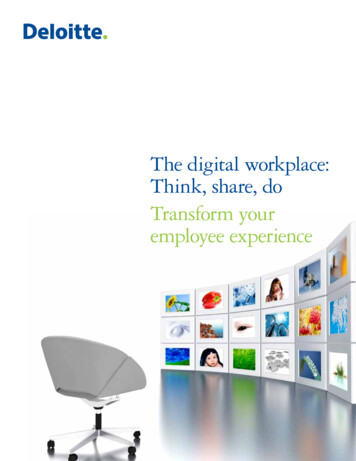
Transcription
The digital workplace:Think, share, doTransform youremployee experience
Gone are the days when the workplace was merely a physical spaceemployees occupied during regular office hours. Today's always connected,instant access environment has blurred the lines between the physicaloffice and the place where work actually happens. As the distinctionbetween professional and personal life dissolves, and the workplacebecomes truly digital, employees are communicating and collaborating inunprecedented ways. To enable knowledge sharing across the organization,they want the ability to forge productive business relationships beyondnatural work groups. As a result, it is increasingly clear that the traditional'create and push' information approach no longer meets employees’evolving needs.To accurately reflect their staff’s changing work experience, leadingorganizations have begun to implement an entirely new workingenvironment – the digital workplace. By integrating the technologies thatemployees use (from e-mail, instant messaging and enterprise social mediatools to HR applications and virtual meeting tools), the digital workplacebreaks down communication barriers, positioning you to transform theemployee experience by fostering efficiency, innovation and growth. Thekey to success, however, lies in the effective implementation of a digitalworkplace strategy capable of driving true cultural change.The digital workplace: Think, share, do1
yeeplomeed encve erior xpeIncreasedrevenuComplianceeImpBusiness driversess agin gMobili t yThe digital workplace: Think, share, doonasreIncagilityandflexibilityImproeved customer experiencrateGretivaoinnFastertime-to-marketm u nicateRiskmumpncComsCoapaernssn icinea tioB usGovtytividuc essnr proHighe fectivefand recruitme nger tant an lentd retentionTechnology
Embrace the evolutionTrack changing trendsWhile the workplace began transforming as far back asthe agricultural and industrial revolutions, the widespreadproliferation of information technology forever changedthe ways in which employees connect, collaborate andcommunicate.This change accelerated over the last 30 years due to theemergence of three fundamental trends: Aging workforce: as the baby boomers continueto retire, they are taking key knowledge with them,increasing the need to capture their knowledge. Information overload: information is still growing atexponential rates and employees can’t find what theyneed, even with technology advances. The need for speed: with the rapid pace of today’swork environment, employees increasingly need to workfaster and collaborate more effectively to get their jobsdone.As workplace demographics continue to shift, employersstruggle to meet the varying needs of a multi-generationalworkforce. As the use of the Internet and mobile devicesgrows, the pace of change continues to accelerate. Thesechanges are further exacerbated by ongoing demands toincrease productivity and cut costs, making it harder foremployees to meet market expectations. Together, thesetrends are reshaping the work environment.Respond to changeThe emerging digital workplace can address theseconcerns by helping organizations: Support changes in working styles that enableemployees to work more transparently and betterleverage social networks. Unify offline and online communications bykeeping employees connected through their mobiledevices to provide anywhere, anytime access to tools andcorporate information. Focus on employee experience by providing themwith user experience they have outside the firewall.Provide choice, flexibility and personalization. Support virtual work environments that allowemployees to stay connected in distributed andvirtualized work locations while balancing customerprivacy and operational risk. Minimize spending and enhance productivityby providing employees with the right tools and rightinformation at the right time. Win the war on talent by offering the progressiveand innovative environments that top candidates nowexpect.The digital workplace: Think, share, do3
Define the digital workplaceWhat is a digital workplace?The digital workplace can best be considered the naturalevolution of the workplace. Comprised of your employees’technology working environment.Why adopt a digital workplace strategy?If the risks of inaction are not sufficient motivators,the benefits of adopting a digital workplace make acompelling business case. Consider the gains in:The digital workplace encompasses all the technologiespeople use to get work done in today’s workplace – boththe ones in operation and the ones yet to be implemented.It ranges from your HR applications and core businessapplications to e-mail, instant messaging and enterprisesocial media tools and virtual meeting tools. Talent attraction: 64% of employees would opt fora lower paying job if they could work away from theoffice.1 Employee productivity: organizations with strongonline social networks are 7% more productive thanthose without.2 Employee satisfaction: organizations that installedsocial media tools internally found a median 20%increase in employee satisfaction.3 Employee retention: when employee engagementincreases, there is a corresponding increase in employeeretention by up to 87%.4 Communication tools: information workers prefernewer communication tools, particularly instantmessaging, over more traditional ones like e-mail orteam workspaces.5Because most organizations already use many of thesecomponents, you generally do not have to build thedigital workplace from the ground up. In fact, if your staffrespond to e-mails from smartphones, check their paystubs online or digitally enter a sales opportunity, you maybe closer to operating a digital workplace than you think.Yet even in cases where new technologies are required, thebenefits increasingly outweigh the costs. As the workplacecontinues to evolve, and employee expectations shift,organizations that do not embrace the digital workplacerisk falling behind.Given these advantages, more organizations arecommitting IT budget on supporting digital workplacestrategies that promise to deliver measurable returns. Thistrend is only set to accelerate as employees increasinglychoose to forge productive business relationships beyondnatural work groups in an effort to enhance knowledgesharing across the organization.To support these outcomes, you need to provideemployees with the tools they require to collaborate,communicate and connect with each other. You need tocoordinate your technology groups and investments toavoid the traps of siloed implementations and disparateownership. You should adopt clear roadmaps to ensureyour digital workplace delivers measurable businessvalue while mitigating risks and adhering to compliancerequirements.4The digital workplace: Think, share, do
The digital workplace frameworkWhile there are no hard and fast rules governing the design of a digitalworkplace, leading practices do exist. The following digital workplaceframework, for instance, provides organizations with a tool to understand theircurrent digital workplace and identify areas of opportunity to support a betterway of doing business by helping you think holistically about the tools you usein your workplace.The digital workplace framework includes four layerscovering the following components:eImpCompliancea tioRiskmpm u nicateCoapmussn icinencComseMess agin gMobili t bolStrorecruitme nger tant an lentd retentioncostsratingopeedducReProductyivictB usaernBusiness drivers: measurable business valueAs with any core initiative, it is essential for business needsto drive the digital workplace. To deliver the necessarybenefits, the direction of your organization should guidethe direction of your digital workplace.GovControl: governance, risk and complianceThe effective use of technology in the digital workplace isunderpinned by appropriate controls. This means you mustsupport the digital workplace with appropriate governancestructures and management processes. Information flowand use must also comply with your organization’s policiesand industry regulations.IncreasedrevenuTechnologytytividuc essnr proHighe fectivefand eTechnology: the digital toolboxTechnology enables the digital workplace. Eachorganization already has a digital workplace toolbox withdifferent tools. Depending on your industry and businessneeds, the tools needed to support your digital workplacewill vary. The key is to adopt the right tools for youremployees to do their jobs.yeeploem nced eve riro xpeeitytivUse: collaborate, communicate, connectThe digital workplace is all about the employees’ abilityto do their job by collaborating, communicating andconnecting with others. The goal is to forge productivebusiness relationships within and beyond natural workgroups and to enable knowledge sharing across theorganization.Business driversImproeved customer experienciatovnnriateGreLeverage your existing investmentto support a new and better way ofdoing businessThe digital workplace: Think, share, do5
IncreaseCompliancerevenueImBusiness driverseeloymp cee e ienov erpr expncna tiomumRiskpm u nicateCoApaernssn icineGovBusetytividuc essnr proHighe fectivefand eComsMess agin gMobili t gng costseratie opducReProducitytivStrorecruitem nger taent a lennd tretentionTechnologytyivictImproeve customer experienctivanor inateGreUse: collaborate, communicate and connectThe implications of cultureIt is no secret that your organization’s culture guidesthe way your employees behave and work. People andculture lie at the heart of organizational performance andtypically drive both success and failure. This means yourculture ultimately determines how and to what extentyour employees leverage the digital workplace to connect,communicate and collaborate.The key is to understand how your employees preferto work. You can then develop a change managementplan and digital workplace strategy that aligns to yourorganizations working culture.By fostering this type of cultural change, and unifying yourtechnology components, the digital workplace can helpyou improve: Collaboration: to solve business problems and operateproductively, organizations need the ability to leverageknowledge across the enterprise with online, seamless,integrated and intuitive collaboration tools that enhanceyour employees’ ability to work together. Communications: as information continues togrow at an unprecedented rate, more tools exist thatenable people to create their own content, rather thansimply consuming existing content. To ensure the rightinformation reaches the right audience, employees needtools that support two-way communication and thepersonalization of content. Connections: self-sufficiency no longer guaranteeseffectiveness. Employees need tools that allow them toconnect across the organization, leverage intellectualproperty and gain insight from one another. The digitalworkplace delivers on these goals by fostering a strongersense of culture and community within the workplace.Online, seamless,integrated and intuitivecollaboration tools playa dominant role in yourworkplace6The digital workplace: Think, share, do
IncreaseCompliancerevenueImBusiness driverseeloymp cee e ienov erpr expncna tiomumRiskpm u nicateCoApaernssn icineGovBusetytividuc essnr proHighe fectivefand eComsMess agin gMobili t gng costseratie opducReProducitytivStrorecruitem nger taent a lennd tretentionTechnologytyivictImproeve customer experienctivanor inateGreTechnology: the digital workplace toolboxYour digital toolbox is comprised of the tools and technologies your employeesneed to do their jobs. All organizations have a digital toolbox but their toolsvary depending on their industry and job functions. Ideally, your businessstrategy and the goals of your digital workplace initiative should determinewhich tools belong in your digital toolbox.Build your digital workplace toolboxIn most organizations, the digital workplace toolbox can bebroadly defined in eight categories to support the ways inwhich you communicate, collaborate, connect and deliverday-to-day services. Too often, organizations implementthese tools in silos without the benefit of a holistic digitalworkplace strategy.To remedy this issue, you should take the time to createa digital workplace strategy that clearly articulates yourbusiness focus and can guide the development of yourdigital toolbox. By assessing your capabilities in eachcategory, you can then identify your focus areas and referto your organization’s culture and business requirements toidentify the tools you most onProvides a fast way tocommunicate with yourcolleagues E-mail Instant messaging Micro Blogging Mobile messagingEnables knowledgeworkers to get theirjobs done efficiently Word processors Spreadsheet software PresentationSoftware CalculatorEnable employees towork with each otherand with partners Team rooms Communities Wikis Web conferencingSupports informationsharing and internalpublishing Portals/intranet Blogs PersonalizedHomepageCrowd sourcingConnectivityMobilityEnables organizationto gather ideas ,inputsand thoughts fromemployees Ideation platform Polling Survey ForumsHelps locate expertsand colleagues acrossthe organization Employee directory Organization chart Rich profileEnables access of toolsaway from the physicaloffice or workplace PC/laptop Mobile/smart phone Home office Remote scannersBusinessapplicationsEnable employeesto access self-serviceapplications online Expense claims HR systems ERP CRMThe digital workplace: Think, share, do7
IncreaseCompliancerevenueImBusiness driverseeloymp cee e ienov erpr expncna tiomumRiskpm u nicateCoApaernssn icineGovBusetytividuc essnr proHighe fectivefand eComsMess agin gMobili t gng costseratie opducReProducitytivStrorecruitem nger taent a lennd tretentionTechnologytyivictImproeve customer experienctivanor inateGreControl: governance, risk and complianceBeyond setting a strategy and building your digital workplace toolbox, youneed to resolve any challenges your organization may face in the areasof governance, risk and compliance. When creating a digital workplace,organizations must also develop a governance model that supports connectivityand collaboration while mitigating risks and enabling compliance.Components of digital workplace governance Guiding principles: identify the business goals youare trying to achieve with the digital workplace andtranslate them into guiding principles to drive ongoingdevelopment. Information governance strategy: determine thefocus of your digital workplace strategy and align it withyour organization’s existing information management orinformation governance strategy. Roles and responsibilities: identify your keystakeholders and create a suitable and sustainableinteraction model. Define governance processes, metricsand oversight processes. Training and certification: ensure your employeeshave access to training that allows them to harness thedigital workplace to their advantage. Also track andensure that technical personnel are trained and certifiedto properly support the underlying technology.Risk mitigation and compliance Information monitoring, collection and analysis:this allows you to determine the information beingshared and the risks that may impair your organization’sreputation, competitive edge, productivity or protectionof confidential information. Policy training: in addition to technical training,employees need policy training on the type ofinformation they should or should not share in the digitalworkplace. You must also communicate policies onhow to properly handle personal data and how to avoiddamaging your organization’s brand. Orchestrated presence: organize your channelswithin the digital workplace. Orchestrate the flow ofinformation to and from different channels. Avoida disjointed model where different groups leveragedifferent tools and communicate in silos. Crisis management: news travels fast thanks to thedigital workplace’s social networking capacity. If a crisisoccurs, react quickly (within the first day), be transparent,establish a listening platform and create a dialogue.Develop a governance modelthat maximizes connectivityand collaboration whilemitigating risks8The digital workplace: Think, share, do
IncreaseCompliancerevenueImBusiness driverseeloymp cee e ienov erpr expncna tiomumRiskpm u nicateCoApaernssn icineGovBusetytividuc essnr proHighe fectivefand eComsMess agin gMobili t gng costseratie opducReProducitytivStrorecruitem nger taent a lennd tretentionTechnologytyivictImproeve customer experienctivanor inateGreBusiness drivers: measurable business valueBy connecting employees beyond the boundaries of their geographies ordepartments, the digital workplace empowers your people to direct theirefforts from the bottom up, build communities of interest, drive knowledgemanagement and collaborate in ways that make sense to them and deliversmeasurable business value.What does it mean to your organization?To realize these benefits, your digital workplace mustaddress existing challenges and provide business value.Your employees need to know what is in it for them. Hereare some ways to achieve measurable value: Increase revenue: provide applications that helpemployees identify cross-sell and up-sell opportunities Reduce operational costs: introduce moreeffective ways to meet virtually, cutting travel andtelecommunication costs and eliminating wasted time atthe airport Accelerate time-to-market: supply tools to helpresearch, develop, test and deliver new products andservices more quickly, such as remote scanners that letyou fulfill orders remotely Enhance innovation: foster two-way communicationto drive discussions and build communities of interestand practice to drive the innovation agenda Improve the customer experience: enable employeesto find the information they need more quickly and servetheir customers more efficiently Increase agility and flexibility: provide the tools thatmimic organization and business changes and reflectemployee behaviours Heighten staff satisfaction: implement easy-to-usetools that can be used the same way both inside andoutside the firewall Raise productivity and efficiency: provide toolsand technologies that help employees execute businessprocesses and functions as currently designed Strengthen talent recruitment and retention:develop a brand of exceptional work environments Improve employee experience: provide the righttools at the right time for their employees to their jobsTangible results Time savings: one company found that a manager saved 43 minutes a month with improved workplace tools.With over 30,000 managers, the company estimated an annual productivity increase of 12 million. Customer efficiency: sellers reduced the time they spent on management activities by one to three hours due tosystem integration and increased collaboration tools.Address existing challenges andprovide value in new waysThe digital workplace: Think, share, do9
Make it realThe digital workplace exists in every organization and industry today. It willtake a different form depending on what your industry is and what yourbusiness needs are. The technologies within your organization and howthey are used will vary.Financial servicesSubscribing to communication channels of interest to you Challenge: Financial institutions are highly competitive and employees are often under time pressures to provide answersto their customers. Information is frequently pushed to front line employees in a cascading fashion and does not supporttwo-way communication. Scenario: Andrew, a small business advisor (SBA), has recently joined the financial institution and is meeting with a fewcustomers to discuss their borrowing needs. Traditional outcome: Unsure of how best to prepare for these meetings, Andrew tries to call a few people he has met inthe small business banking area. Most do not respond, but David, another SBA directs him to two other SBAs, one of whomprovides him with the training manual. Digital workplace outcome: Andrew comes into the office and sees news personalized to the small business bankingadvisors on his home page. He sees a link to subscribe to news and browses the channels available for subscription. He findsa channel for “Small business banking with professionals”. The news stream is added to his job-related news and he learnsabout new developments in this space. He meets his clients with a pre-understanding of the type of challenges they face andgreat opportunities for the bank to assist them financially.Public sectorConnecting with experts to make the right business decisions Challenge: Many government departments deal with complex decision making on a day-to-day basis. Public servants needto make business decisions based on policy, legislation, and other directives. Knowing that their decisions have a directimpact on citizens and immigrants, the right decisions need to be made. Scenario: Maria is an immigration officer processing a residency application. She comes across some information in theapplication that needs to be reviewed against current policy that she is not yet familiar with. Traditional outcome: Unsure of the decision to make, Maria searches for the policy document. Struggling to find the mostrecent version, she is now faced with the task of familiarizing herself with the document. After reading pages of content, shefinds the relevant section. Maria is still not 100% certain of the right decision but decides to go with her gut feel. She hasmade a decision that took a lot of time and may not be the right one. Digital workplace outcome: Unsure of the decision to make Maria sends an instant message to a colleague. Hercolleague gives her two names to follow up with as they cannot remember which one is the policy expert. Maria is able tovisit their professional profiles, identify the right person and instantly connect with them. They give Maria the right answerand are even able to point her to the latest policy document and sub clause so that she can verify the decision for herself.Maria has made the right decision and in a timely manner.Energy & resourcesCollaboration beyond boundaries to solve business problems Challenge: Oil companies have widely dispersed global teams that need tools to enable collaboration, irrespective ofgeographical locations. With increasing pressure to find new oil supplies, this industry is facing a challenge to meet growingenergy needs around the world. Scenario: Lenard, a drilling surveyor, needs access to site information to make sure that the right location-based informationis used. Once obtained, he needs to validate elements before it can be passed to the engineers. Traditional outcome: Lenard asks one of his colleagues to provide him with the required document. After a few days, thedocument is finally tracked down. Productivity suffers as remote and geographically dispersed employees struggle to workcollaboratively on documents and access corporate information. Digital workplace outcome: Lenard navigates to the team’s community page where he is able to access all workingdocuments. He makes his changes directly to the document and notifies the rest of the community once complete. Theteam lead is able to author the document at the same time allowing changes to be seen in real time. Lenard is then able toconfirm the document as final and forwards it with the agreed coordinates.10The digital workplace: Think, share, do
Facilitate the sales processBy enabling all aspects of the digital workplace, you can simplify the sales process, increase awareness of salespursuits and reduce 'information clutter.'All groups have visibilityof immediate customerissues via the CRM.Sales reps searche formarketing experts via theemployee directory andrich profiles search.Sales team membersworking from homeshare relevant insight onpast sales history.PDFMarketingSalesPPTMarketing team accessesthe work-in-progress RFPand adds insights.XLSProductdevelopmentDOCProduction managersshare upcoming featureswith the sales team viaweb conferencing.CustomersupportThrough emails withthe customer's supportmanager, additional salesinsights are gathered.Improve diagnosis and treatment efficiencyUnified electronic patient records (EPRs), instant notifications and secure discussion boards ensure efficient andproper treatment of patients. They also reduce the paperwork and clutter associated with this process.76Patient is notified of thefollow-up appointmentwith the rheumatologistvia a calendar invite.Neurologist notifiesthe patient of theappointment via emailand findings are updatedto the EPR. Neurologistsends a follow-up emailto the Rheumatologist.Patient is examined byphysician and may havecarpal tunnel. Physicianwrites up report intothe patients EPR andrequests icianMedicallab5The Rheumatologist andthe neurologist discussesfindings and decides tosolicit input from otherphysicians through asecure, official discussionboard setup and isreferred to similar cases.Rheumatologist reviewsthe results from herblackberry and requestsfor a neuro consult andan EMG test.4Physician's office notifiesrheumatologist of theupcoming appointmentvia email calendar inviteincluding a link to thepatient's EPR.Patient gets additionalblood work done,Medical lab directlypopulates the resultsinto the patients EPR.Notification is sent to therheumatologist.123The digital workplace: Think, share, do11
Digital workplace case studiesAs the digital workplace delivers on its potential, it is finding traction across abroad array of industries. Already, success stories thrive:HealthcareMinimal training with maximum benefits Company snapshot: With 18,000 employees, RehabCare provides rehab and post-acute care services, operating in over1,200 hospitals and facilities across 43 states. Challenge: At RehabCare, every minute counts – employees need to track and record every detail, including the diagnosis,treatment and when the appointment began and ended. Digital workplace solution: RehabCare equipped its staff with easy-to-use, process-driven applications on iPhone and iPadmobile devices. The mobile devices are used at point-of-care to capture information quickly and easily, such as the treatmentdelivered, the time spent and other relevant clinical information. The cloud-based applications allow access to detailedpatient information anytime anywhere. Key benefits: The devices offer an intuitive user interface that requires minimal training and appeals to employees.RehabCare estimates it is saving millions per year in job retention as a result of iPhone and iPad integration. Beforethis integration, patient pre-admission screening was a time-consuming process involving multiple paper forms andquestionnaires.Source: Apple Inc.6Financial servicesUsing technology to foster deep and lasting relationships Company snapshot: Standard Chartered Bank is an international bank with 1,800 branches on six continents, dozens ofrecent industry awards and steadily-increasing profits through organic growth and acquisitions. Challenge: In the wake of the 2009 global financial crisis, Standard Chartered Bank immediately set to work reinforcingcustomer relationships. The Head of Consumer Banking in Hong Kong stated: “As a leader in the industry, we needed toregain customer confidence. And rebuilding that confidence is not about just pushing products and services – it’s about usingthe best technology to foster deep, longstanding relationships with our customers. It’s about helping them manage theirmoney better.” Digital workplace solution: For consumers and corporate customers, the bank developed a suite of mobile banking andlifestyle applications. Corporate customers use the bank’s Sraight2Bank platform, which includes a mobile authorization appthat gives corporate treasurers better control over transactions. Internally, Standard Chartered deployed thousands of iPhonesto employees worldwide, developed more than a dozen in-house iPhone applications and is rapidly expanding its iPad use. Key benefits: iPhone and iPad use helped personalize customer service, simplify everyday business activities, streamlineinternal processes, securely transmit financial data, improve communication between customers and banking staff, and eventap into back-end systems for approvals and collaboration.Source: BRO Study Online712The digital workplace: Think, share, do
TransportationQuickly building a full repository of information Snapshot: With 9,800 employees, Alaska Airlines provides a fleet size of 117 aircrafts across 91 destinations operating allover the United States. Challenge: Alaska Airline pilots must carry 25 pounds of hardcopy flight manuals every flight. These manuals must also bereprinted for all pilots every time a change is made to their information. Digital workplace solution: Alaska Airlines equipped all its pilots with iPad tablets that hold all flight manuals. The iPadenables pilots to find a full repository of information faster and easier in one location, as well as provide instant updates tothe manuals before and after a flight. Pilots can also access additional information in the manual with a simple link. It hasbecome the pilots’
stubs online or digitally enter a sales opportunity, you may be closer to operating a digital workplace than you think. Yet even in cases where new technologies are required, the benefits increasingly outweigh the costs. As the workplace continues to evolve, and employee expectations shift, organizations t
